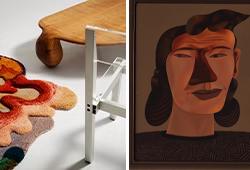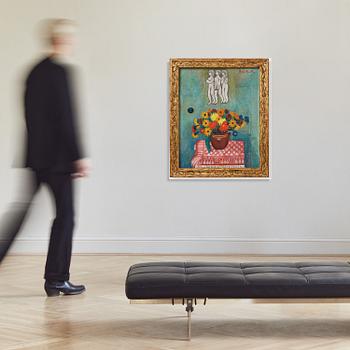Bror Hjorth
"Blommor och elektrisk kontakt"
Signed Bror Hjorth. Dated 1946 verso. Canvas 99 x 81 cm. Including frame executed by the artist 117 x 97.5 cm.
Kirjallisuus
Bror Hjorth, "Mitt liv i konsten", 1967, ill. p. 75.
Muut tiedot
Bror Hjorth's artistic starting point was as a sculptor and it was to train as such that he traveled to Paris in 1921. He began studying sculpture with the sculptor Antoine Bourdelle, who was to have a major impact on the young Hjorth's development as an artist. This is what Bror Hjorths Hus writes: “He had seen painting mostly as a hobby, and it was by chance that he took it up seriously. He had been annoyed by a studio mate's paintings and wanted to show how it should look. More paintings followed, and over time, painting became as important a part of his art as sculpture.
Initially, Bror Hjorth painted mostly Swedish subjects, fantasy images of his childhood environment outside Uppsala. In the artist Paul Gauguin, Bror Hjorth had found an artistic role model, an artist who sought the original and primitive, both in opposition to and in harmony with the modern era and its ideas. But instead of seeking the original in Tahiti, as Gauguin did, Bror Hjorth looked back to his own home region and history.”
When Bror Hjorth and his family returned to Uppsala from Paris in the early 1940s, a few intense years followed in which Bror felt that the inhibitions he had had for painting were released. He had new models to work with, new friends and a lively social life. In his production after his return to Sweden, the environment is often familiar and one or two details let us know that the artist feels at home. The frame, sculpted by the artist himself, testifies to his mastery not only of the brush, but also of the miretta and chisel. In Hjorth's paintings, volume is important; he believed that just as a simple contour drawing expresses volume, so should a simple color plane. The flat surface of a drawing or painting must be maintained and it must be possible to see the volume through the surface.
In the auction painting, Bror Hjorth has combined sculptural elements both in the hand-carved frame and in the choice of subject matter. Above the pot of flowers, he has added a classical element with what looks like a relief in marble with three antiquated figures. He has an unerring sense of color, using the three primary colors of blue, yellow and red to create a vibrant energy.


























































